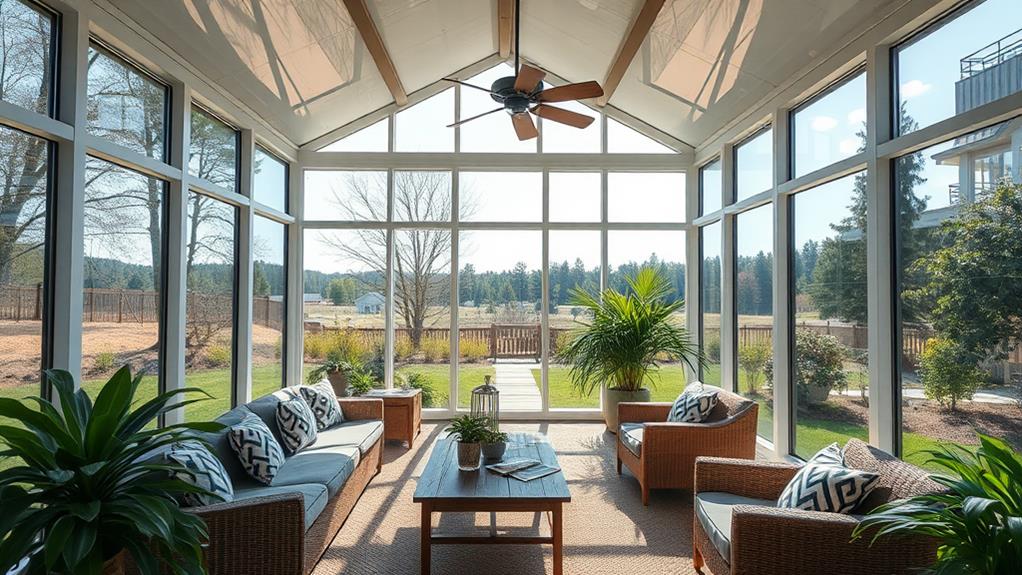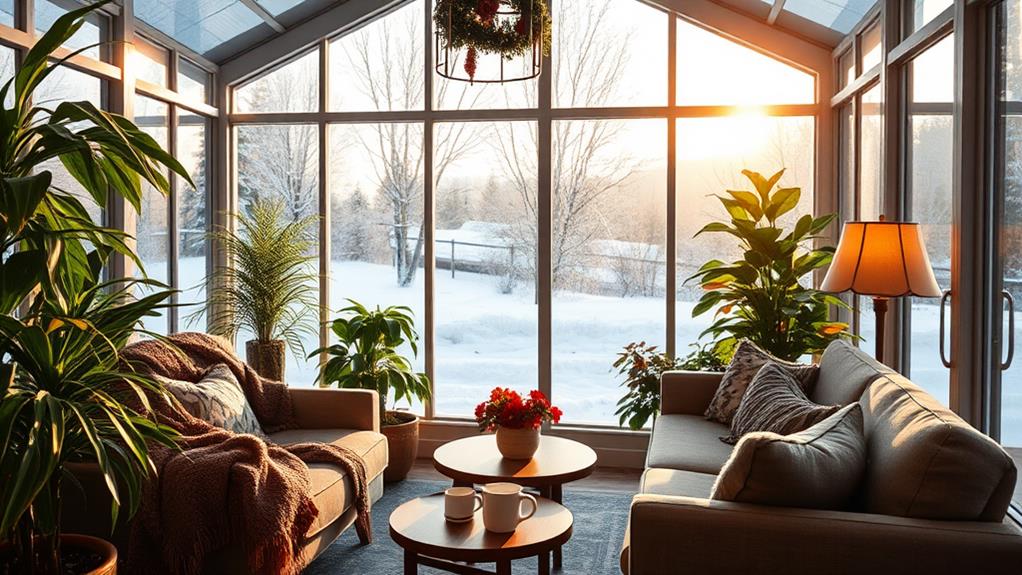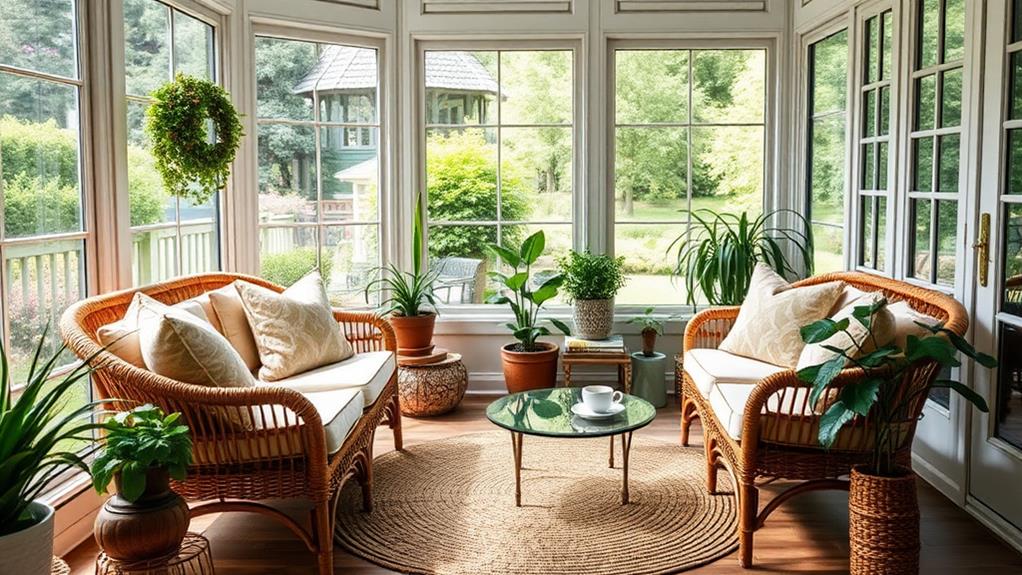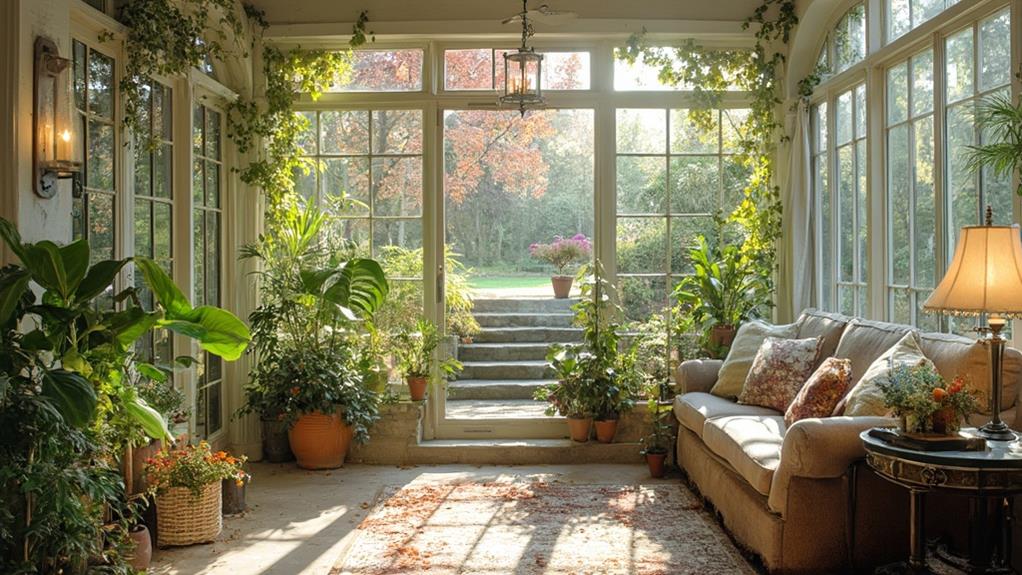A four-season sunroom is a versatile addition that seamlessly connects indoor living spaces with the outdoors, offering year-round enjoyment. These rooms feature high-quality insulation, energy-efficient windows, and climate control systems integrated with the home's HVAC. They can serve multiple purposes, from cozy winter retreats to refreshing summer oases, enhancing both livability and property value. Four-season sunrooms come in various styles, from traditional to contemporary, and can be customized with different materials and finishes. Proper design ensures energy efficiency and comfort in all seasons. Exploring the benefits and considerations of these unique spaces reveals their potential to transform home living experiences.
What Is a Four-Season Sunroom?

A four-season sunroom seamlessly blends indoor comfort with outdoor ambiance, offering a versatile living space that can be enjoyed year-round. Unlike traditional three-season sunrooms, which may become too cold or hot during extreme weather, a four-season sunroom is designed to maintain a comfortable temperature regardless of the season.
These structures typically feature high-quality insulation, energy-efficient windows, and climate control systems to ensure optimal comfort. The walls are often constructed with a combination of glass and solid materials, providing both natural light and thermal efficiency. Four-season sunrooms are fully integrated into the home's heating and cooling systems, allowing for consistent temperature regulation.
The design of a four-season sunroom can vary widely, from contemporary glass enclosures to more traditional styles that complement the existing architecture of the home. These spaces serve multiple purposes, functioning as additional living areas, dining rooms, home offices, or even bedrooms. By effectively bridging the gap between indoor and outdoor environments, four-season sunrooms allow homeowners to experience nature's beauty while enjoying the comforts of interior living, making them a popular choice for those seeking to expand their living space and enhance their home's value.
Design Options and Styles
Exploring the design options and styles for four-season sunrooms reveals a vast array of possibilities to suit various architectural preferences and functional needs. Traditional designs often feature gabled roofs and classic window configurations, complementing colonial or craftsman-style homes.
Contemporary styles may incorporate sleek lines, expansive glass panels, and minimalist framing for a modern aesthetic.
Materials play a crucial role in design, with options ranging from aluminum and vinyl to wood and composite materials. Each offers unique benefits in terms of durability, maintenance, and visual appeal. Roofing choices include glass, polycarbonate, or insulated panels, each impacting light transmission and thermal efficiency.
Interior finishes can mimic the main house or create a distinct atmosphere. Flooring options span from tile and hardwood to heated floors for year-round comfort. Ceiling fans, skylights, and integrated lighting systems enhance functionality and ambiance.
Customization extends to window treatments, allowing for privacy and light control. Retractable screens, blinds, or curtains offer versatility. Some designs incorporate operable windows or sliding glass doors to maximize ventilation and seamlessly connect with outdoor spaces, further blurring the line between indoors and outdoors.
Benefits of Year-Round Use

Four-season sunrooms offer a multitude of benefits that extend throughout the year, making them a valuable addition to any home. These versatile spaces provide a seamless connection to nature while maintaining comfort in all seasons.
During winter, they serve as cozy retreats, allowing occupants to enjoy natural light and scenic views without exposure to harsh elements. In spring and fall, they offer ideal spots for relaxation and entertainment, protected from unpredictable weather.
Summer transforms the sunroom into a refreshing oasis, shielded from intense heat and insects while still providing an outdoor ambiance. Year-round, these spaces can function as home offices, art studios, or meditation areas, enhancing productivity and well-being. They also contribute to energy efficiency by acting as thermal buffers between the main living areas and the outdoors.
Additionally, four-season sunrooms increase a home's overall square footage and market value, offering a cost-effective alternative to traditional home additions. By providing a flexible space that adapts to changing needs and seasons, these sunrooms maximize the utility and enjoyment of a home throughout the entire year.
Energy Efficiency Considerations
While four-season sunrooms offer numerous benefits, their energy efficiency is a key factor in their overall value and performance. Proper insulation, high-quality windows, and strategic design are essential for maintaining comfortable temperatures year-round while minimizing energy consumption.
Insulation plays a crucial role in regulating temperature and reducing heat transfer. Walls, ceilings, and floors should be well-insulated to prevent heat loss in winter and heat gain in summer. Double or triple-pane windows with low-emissivity coatings and argon gas fill can significantly improve thermal performance, reducing heating and cooling costs.
Proper ventilation systems, including ceiling fans and operable windows, can help maintain air circulation and reduce reliance on artificial heating and cooling. Additionally, incorporating thermal mass materials like concrete or tile flooring can help regulate temperature fluctuations.
Energy-efficient lighting options, such as LED bulbs and smart controls, can further reduce electricity consumption. Solar shades or retractable awnings can provide shade during hot summer months, decreasing cooling needs. By carefully considering these energy efficiency factors, homeowners can create a comfortable, sustainable four-season sunroom that seamlessly integrates with their living space while minimizing environmental impact and utility costs.
Furnishing Your Sunroom

Selecting the right furnishings for your sunroom is crucial to creating a comfortable and inviting space that seamlessly blends indoor comfort with outdoor aesthetics. Choose furniture that can withstand exposure to sunlight and temperature fluctuations while complementing your home's overall style. Opt for materials like wicker, rattan, or weather-resistant fabrics that are durable and easy to maintain.
Consider versatile pieces such as modular seating arrangements or furniture with hidden storage to maximize space efficiency. Incorporate a mix of comfortable seating options, including lounge chairs, sofas, and ottomans, to accommodate various activities and gatherings. Add a coffee table or side tables for convenience and to display decorative items.
To enhance the room's connection with nature, incorporate plants and natural elements into your decor. Use lightweight, movable planters to add greenery and create a lush atmosphere. Accent your sunroom with outdoor-inspired accessories like throw pillows, area rugs, and curtains in nature-inspired patterns or colors. Finally, consider installing adjustable lighting options, such as dimmer switches or floor lamps, to create the perfect ambiance for any time of day or evening relaxation.
Maintenance and Care Tips
Maintaining your four-season sunroom is essential for preserving its beauty and functionality throughout the year. Regular cleaning is crucial, including dusting surfaces, wiping down windows, and vacuuming or sweeping floors. Use appropriate cleaners for different materials, such as glass cleaner for windows and mild soap for furniture.
Inspect the sunroom's structure periodically for signs of wear, damage, or leaks. Check window seals, door frames, and roofing materials for potential issues. Address any problems promptly to prevent further damage or energy loss.
Monitor humidity levels to prevent condensation and mold growth. Use a dehumidifier if necessary, especially during humid seasons. Ensure proper ventilation by opening windows or using fans when weather permits.
Maintain heating and cooling systems according to manufacturer recommendations. Clean or replace filters regularly and schedule professional inspections annually.
Protect furniture and fabrics from sun damage by using UV-resistant materials or window treatments. Rotate cushions and rugs periodically to ensure even wear.
Trim nearby trees or bushes to prevent debris accumulation on the roof or gutters. Clean gutters regularly to ensure proper drainage and prevent water damage.
Cost and Return on Investment

Investing in a four-season sunroom typically costs between $20,000 and $80,000, depending on size, materials, and customization. Factors influencing the price include the room's dimensions, foundation requirements, insulation quality, and chosen amenities. High-end features like radiant floor heating, smart glass, or custom woodwork can significantly increase the overall expense.
While the initial investment may seem substantial, a four-season sunroom can offer a considerable return on investment (ROI). On average, homeowners can expect to recoup 60-80% of their investment when selling their property. The added living space increases the home's square footage and enhances its market value.
Moreover, the energy-efficient design of modern sunrooms can lead to long-term savings on heating and cooling costs. Beyond financial considerations, the intangible benefits of a four-season sunroom contribute to its value. The enhanced quality of life, increased natural light exposure, and expanded living space provide year-round enjoyment for homeowners. When evaluating the cost-benefit ratio, it's essential to consider both the monetary and lifestyle advantages that a four-season sunroom brings to your home.
Integrating With Existing Architecture
A critical aspect of adding a four-season sunroom to an existing home is ensuring seamless integration with the current architectural style. This integration involves careful consideration of design elements, materials, and structural features to create a cohesive look that enhances rather than detracts from the home's overall aesthetic.
Key factors in achieving successful integration include matching rooflines, siding materials, and window styles. The sunroom's roof should complement the existing structure, whether by mimicking the pitch or incorporating a transitional design that blends the two. Selecting exterior finishes that match or harmonize with the home's current siding is crucial for visual continuity. Window styles and sizes should also be consistent with those in the main house.
Color coordination is another vital aspect of integration. Choosing paint colors, trim, and accents that align with the existing palette helps the sunroom appear as a natural extension of the home. Additionally, considering the placement and orientation of the sunroom in relation to the house's existing layout can significantly impact its integration. Properly positioned, a four-season sunroom can enhance the home's overall flow and functionality while maintaining architectural integrity.
Frequently Asked Questions
How Long Does It Typically Take to Build a Four-Season Sunroom?
The construction time for a four-season sunroom typically ranges from 2 to 6 weeks, depending on factors such as size, complexity, and customization. Professional contractors can often complete the project more efficiently than DIY approaches.
Can I Convert My Existing Three-Season Sunroom Into a Four-Season Room?
Picture your sunroom transformed: Yes, converting a three-season sunroom to a four-season room is possible. This upgrade typically involves enhancing insulation, upgrading windows, installing HVAC, and potentially reinforcing the foundation to ensure year-round comfort and usability.
Are Permits Required for Adding a Four-Season Sunroom to My Home?
Permits are typically required for adding a four-season sunroom to your home. Local building codes and regulations vary, so it's essential to consult your municipality's planning department or a licensed contractor for specific requirements in your area.
Can a Four-Season Sunroom Be Used as a Legal Bedroom?
While a four-season sunroom may be a ray of sunshine in your home, it typically cannot be used as a legal bedroom. Building codes require specific elements for bedrooms, including egress windows and proper ventilation, which sunrooms often lack.
How Do Four-Season Sunrooms Affect Home Insurance Premiums?
Four-season sunrooms can impact home insurance premiums, potentially increasing them due to added square footage and value. However, improved energy efficiency and durability may offset costs. Consult your insurance provider for specific policy implications and potential discounts.
Conclusion
As the boundaries between indoor and outdoor living continue to blur, the four-season sunroom emerges as a compelling solution. Yet, its true potential remains elusive to many homeowners. While initial costs may give pause, the long-term benefits—from increased property value to enhanced quality of life—are undeniable. The question lingers: in an era of evolving home design, can one afford to overlook this versatile space that seamlessly bridges nature and comfort?

